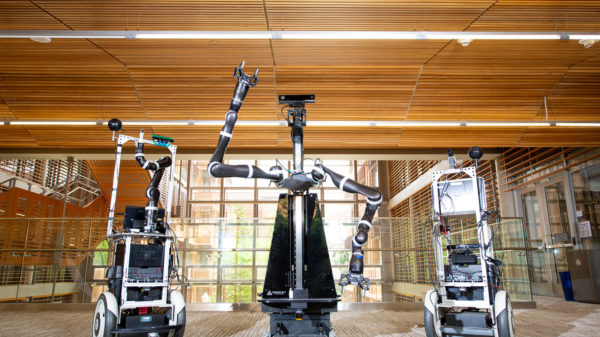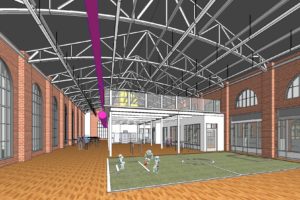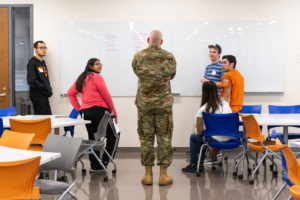
The United States has been at war continuously since 2001. All that time, China and Russia have been modernizing their armies. “For decades the Army has failed to modernize. The threats we face in the future are only going to become more lethal and complex,” says Lt. Gen. James Richardson.
Because of this, in 2018 the U.S. Army decided to create an organization the sole mission of which would be modernization. The Army Futures Command established its headquarters in Austin, and among the reasons it did, Secretary of the Army Mark T. Esper said at the time, was the need “to immerse ourselves in an environment where innovation occurs at speeds far faster than our current process allows. We searched for a location that had the right combination of top-tier academic talent, cutting-edge industry and an innovative private sector.”
This month, Army project directors and staffers from across the country convened at UT with faculty experts in areas where the Army needs innovation. Directors of various Army “cross-functional teams” briefed other Army teams and faculty members on the state of research and current problems.
The symposium was the first of its kind, “but it certainly won’t be the last,” Richardson said. “We’re here today to make good on a promise to partner America’s academic horsepower with our new modernization initiatives. The University of Texas remains the envy of the world because of your unique capabilities to generate creativity and unlock innovation.”
The Army’s priorities include improving navigation systems in long-range artillery, mobile communication networks, and developing the next generation of vertical lift aircraft such as helicopters and drones.


Since that symposium, the UT System Board of Regents approved $20 million to support UT Austin’s collaboration with the Army Futures Command. This was in addition to $30 million UT Austin is committing to strengthen faculty and research capabilities in areas of mutual interest with the Army.
The Army Future’s Command will designate UT Austin as the hub for two of its research programs: Robotics and Assured Positioning, Navigation and Timing. UT will conduct much of the research in these areas itself but also will coordinate and manage the research done on other university campuses. UT will also participate in research directed from the three other hubs, most notably the Hypersonics and Artificial Intelligence hubs and future work on biodefense.
UT’s commitment includes the building out of two facilities. The largest will be a robotics research center in the historic Anna Hiss Gym. This facility will allow students and faculty to work alongside Army personnel. The second, smaller facility will be within the building on the Pickle Research Campus that houses the Center for Electromechanics, where work requiring additional physical security will be conducted.
The ongoing work will allow UT faculty and students to bring research skills to bear on key technical problems the Army must solve to remain competitive. Students will have the opportunity to work closely with Army personnel in ways that enhance their efforts to go on to valuable careers in academia, industry and the military.
The university has been collaborating on national defense for more than 75 years. “The Board of Regents’ visionary support will help UT Austin achieve its bold goals for important work with the Army Futures Command,” says President Gregory L. Fenves. “As we undertake research together that benefits national security, our partnership with the AFC will also prepare students to be leaders in critical technologies.”
Universities are attractive to the military because they typically execute at a lower cost and produce prototypes faster. Their multidisciplinary nature can also lead to more creative solutions. Enhancing the Army’s technology will help protect our national interests and bring more soldiers home safely.

